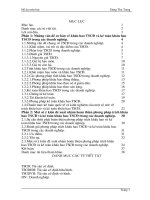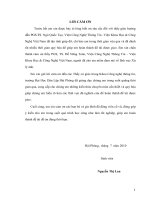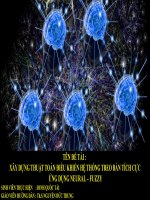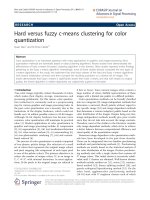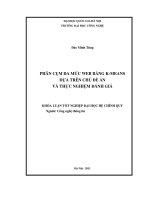Thuật toán Fuzzy C- Means
Bạn đang xem bản rút gọn của tài liệu. Xem và tải ngay bản đầy đủ của tài liệu tại đây (656.8 KB, 35 trang )
THU DAU MOT UNIVERSITY
Faculty of Engineering & Technology
Master's degree in Information Systems
Machine Learning
TOPIC :
GROUP 4 :
FUZZY C-MEANS
NAME
1. Nguyễn Bình Minh
2. Nguyễn Kim Sơn
3. Hoàng Xuân Trường
4. Hồ Ngọc Trung Kiên
5. Trần Nguyễn Thanh Tuyền
6. Huỳnh Văn Thường
ID
1694801040020
1694801040026
1694801040028
1694801040017
1694801040030
1694801040031
Instructor : A-Prof. Dr. QUẢN THÀNH THƠ
OVERVIEW ABOUT CLUSTERING
FUZZY C-MEAN
MPLEMENTATIONS
COMPARISION FCM and K-MEAN
CONCLUSION
What is Clustering?
Clustering can be considered the most
important unsupervised learning;
Clustering could be the process of organizing
objects into groups whose members are similar.
A cluster is therefore a collecton of objects
which are similar between them and are
dissimilar to the objects belonging to other
clusters.
Example :
Before clustering :
After clustering :
The Goals of Clustering
The goal of clustering is to determine the intrinsic
grouping in a set of unlabeled data. But how to
decide what consttutes a good clustering? It can be
shown that there is no absolute “best” criterion
which would be independent of the final aim of the
clustering.
Possible Applications
Clustering algorithms can be applied in many fields, for
instance:
Marketing; Biology; Libraries; Insurance; City-planning;
Earthquake studies; WWW: document classification
INTRODUCTION K-MEANS
• K-means is the most important flat clustering.
• Objectve is minimizing Euclide distance of the
documents from their clusters center.
• A cluster center is defined as vector :
INTRODUCTION FUZZY C-MEANS
• Fuzzy c-means (FCM) is a method of clustering
which allows one piece of data to belong to
two or more clusters. This method (developed
by Dunn in 1973 and improved by Bezdek in
1981) is frequently used in pattern
recogniton. It is based on minimizaton of the
following objectve functon:
FUZZY C-MEAN (FCM)
FUZZY C-MEAN (FCM)
FUZZY C-MEAN (FCM)
FUZZY C-MEAN (FCM)
FUZZY C-MEAN (FCM)
FUZZY C-MEAN (FCM)
FUZZY C-MEAN (FCM)
FUZZY C-MEAN (FCM)
FUZZY C-MEAN (FCM)
Hàm mục tiêu:
Tập nền X= {x1,...,xi,…,xn}
C= {c1,…,cj,…,cc}
FUZZY C-MEAN (FCM)
FUZZY C-MEAN (FCM)
Ví dụ:
Khởi tạo tâm cụm ở điểm 3 và 11 với tham số
mờ m=2
FUZZY C-MEAN (FCM)
1
U11 =
2
2
3
3
2
2 1
2 3
2 11
1
2
2 1
81
98.78%
1 82
1
81
FUZZY C-MEAN (FCM)
U12 =
1
2 11
2 3
2
2 1
2 11
2 11
2
2 1
1
1
1.22%
81 1 82
FUZZY C-MEAN (FCM)
U21 = 100%
U22 = 0%
FUZZY C-MEAN (FCM)
U31 =
1
4
4
3
3
2
2 1
4 3
4 11
1
2
2 1
1
98%
1
50
1
49 49
FUZZY C-MEAN (FCM)
U32 =
1
4 11
4 3
2
2 1
4 11
4 11
2
2 1
1
1
2%
49 1 50
FUZZY C-MEAN (FCM)
1
U41 =
7
7
3
3
2
2 1
7 3
7 11
2
2 1
1
1
50%
1 1 2
